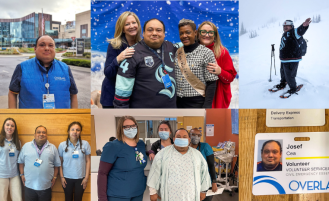When Should I Go to Urgent Care?
May 06, 2021
When your primary care provider is not available or it’s outside of normal business hours, urgent care provides medical attention for common illnesses or minor injuries that require urgent attention but are not life-threatening. Trust your instincts. It’s always better to err on the safer side.
Urgent care clinics offer evening and weekend hours for walk-in appointments. And, at Overlake, you can also schedule your appointment before you leave home.
Even though you will save time and money going to an urgent care, the emergency room is appropriate for serious life-threatening medical conditions.
Please call 911 or go to the nearest emergency room where you are best evaluated for:
- (Severe) abdominal pain
- (Severe) allergic reaction
- (Severe) asthma attack
- (Severe) bleeding
- Bluish lips or face
- Difficulty breathing
- Broken bone with dislocation
- (Severe) burns
- Choking
- New confusion or inability to arouse
- Large dislocated joint
- Sudden dizziness or loss of coordination
- Fainting/change in mental state
- Head injury (with loss of consciousness; age over 65; on blood thinners)
- (Severe) laceration
- Laceration through infected skin
- Deep puncture wounds
- Lacerations that are grossly contaminated with debris
- Lacerations with significant tissue loss
- Lacerations with neurovascular compromise (numbness)
- Lacerations with a fracture, amputation or joint space involvement
- Specialized lacerations (eyelid, nasal cartilage)
- Overdose
- Persistent pain or pressure in your chest or concern that you may be having a heart attack
- Seizures
- Slurred speech
- Major trauma
- Vaginal bleeding in pregnancy
- Sudden vision loss
- Sudden weakness/numbness on one side
Visit urgent care for:
- Mild to moderate abdominal pain
- (Minor) allergic reactions including rashes, bug bites/stings
- Seasonal allergies
- Animal bites
- Mild to moderate asthma
- Back pain
- (Minor) burns (see below)
- (Small) cuts that may require stitches
- Ear pain
- Eye redness, discharge or itchiness
- Flu symptoms
- (Minor) fractures
- Mild to moderate headaches
- Nausea/vomiting/diarrhea
- Painful urination
- Pink eye
- Sinus infection
- Sore throats
- Middle School/High School sports physicals
- Sprains/strains
- Strep throat
- Urinary tract infections
- Wheezing
Do not come to Urgent Care for:
- Physicals:
- for pre-surgery.
- for pre-employment, Department of Transportation, Boys Scouts or camp attendance.
- for mission service.
- for obtaining a commercial driver’s license.
- for FAA or pilot exams, Peace Corps or military.
- for annual wellness exams.
- Prescription refills.
- Well child exams, immunization reviews and updates.
- Blood cultures (go to ER).
- Placing or reading PPD (TB skin test).
- Cryotherapy for wart removal.
- Biopsies to send to pathology.
- Digital rectal disimpaction.
- Urine catheterization.
- Central line dressing changes.
- Breast ultrasounds.
- Fetal ultrasounds.
- Lab draws sent from other clinics.
- Syphilis treatment.
6 Tips to Make the Most of Your Urgent Care Visit
- Information improves care.
- If you are new to Overlake, bring a list of your medical issues, current medications (including dosages), and allergies to any medication, including antibiotics.
- Don’t be embarrassed to ask questions.
- Adjust your expectations. We may tell you a list of things that we do not think you have, rather than tell you what you do have.
- Be accurate about your pain symptoms on a scale of 1–10. Is your pain mild, moderate or severe? For example, 1 is very minor pain that does not interfere with daily tasks; moderate pain is hard to ignore; and 10 is severe pain that makes it hard to take deep breaths or perform usual activities.
Image

- Make sure you review your discharge summary with the provider’s impression, suggested treatments, follow-up recommendations and when you would need to go to the emergency room.
A Word on Burns
First-degree burns are superficial, red (like a sunburn) and painful.
Second-degree burns involve the entire epidermis and a portion of the dermis (the thick layer of tissue below the epidermis) and are very painful; skin is red, blistered and swollen.
Third-degree burns involve the destruction of the entire epidermis and dermis; skin is white, brown, dry, charred or translucent, and there is no pin-prick sensation in the burned area.
Fourth-degree burns involve underlying fat, fascia, and muscle and/or bone.
Minor burns can be treated in the urgent care and are defined as follows:
- Isolated injury without inhalation or electrical suspicion.
- Does NOT involve the face or perineum.
- Does NOT cross major joints.
- Is NOT circumferential (where a full thickness burn affects circumference of a digit, extremity or torso).
- Second-degree burns less than 10% total body surface area in patients 10–50 years old.
- Second-degree burns less than 5% total body surface area in patients under 10 and over 50 years old.
Should an urgent healthcare need arise, rest assured that Overlake Urgent Care is here for you and your family. You can reserve a spot in line, online through our fast and secure scheduling tool before you arrive at the clinic. View Overlake Urgent Care locations across the Eastside.









